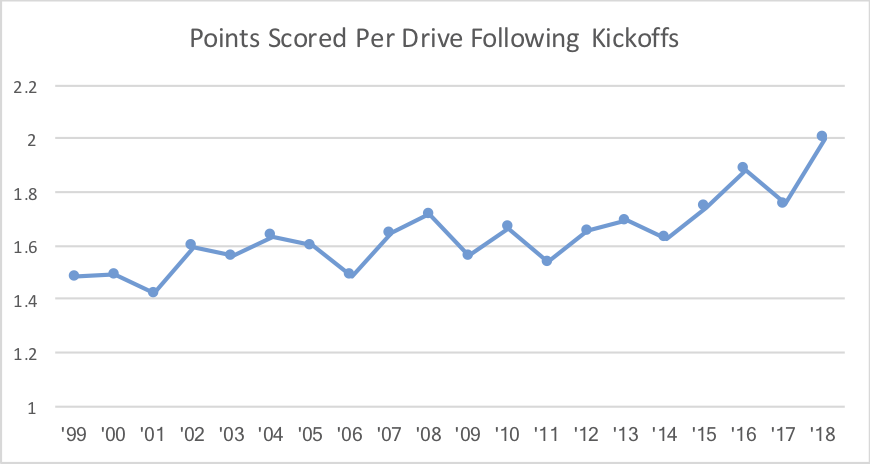Nearly two decades ago, David Romer analyzed data from games during the 1999, 2000, and 2001 seasons. Doug Drinen wrote a series of articles about his paper, and one of Doug’s key takeaways was that the value of possession following a kickoff was worth +0.6 points to the receiving team. The natural extension of this is that it means a touchdown is worth 6.4 points and a field goal worth 2.4 points. That also means that a touchdown isn’t just 2.33 times (7 divided by 3) as valuable as a field goal, but 2.67 times as valuable.
Now how did Romer derive that value of +0.6 points? Or, as Doug wrote, what does it mean to say that it is worth +0.5 points to the team with the ball to have 1st-and-10 at your own 20?
The half-a-point value of a first at the 20 includes not only the points that you might score on that drive, but also the points your opponent might score with the field position you’re likely to give them if you don’t score, and the points you’re likely to score with the field position they give you after they do or don’t score, and so on.
But we don’t need to go into the fine details of the system to get to what I want to talk about today. And that is possession has never been more valuable in the NFL. [1]One other reason: teams are better at making field goals, including from very far away, which means getting into likely field goal range requires less yardage than it used to for the offense.
The graph below shows the average points scored by the receiving team following a kickoff in each season since 1999. Note that this includes all quarters (Romer’s study was mostly limited to the first quarter) and all teams, and only includes points scored by the receiving team (Romer’s study focuses on net points (meaning points scored by the kicking team on the ensuing possession), so the numbers are of course lower). But the key is that teams are scoring more points after kickoffs than they did in the early ’00s.

You can see all the raw data by year here: 1999, 2000, 2001, 2002, 2003, 2004, 2005, 2006, 2007, 2008, 2009, 2010, 2011, 2012, 2013, 2014, 2015, 2016, 2017, and 2018.
From ’99 to ’01, teams averaged 1.46 points per drive [2]Assigning 7 points to each touchdown regardless of what happens after the touchdown, and 3 points to each made field goal. following a kickoff, even though the average field position was right around the 30-yard line. But this year, as of November 24th, teams are averaging an even 2.00 points per drive, despite an average field position of the 26-yard line. This is because possession has never been more valuable.
Let’s say this again: possession has never been more valuable in the NFL. Averaging 2.00 points per drive, even when starting at the 26, is remarkable. And let’s not forget that negative plays are way down: about 17% of these drives from ’99 to ’01 ended in turnovers, compared to just 12% right now. So in terms of net points, it’s possible that the differential is even larger. But at a minimum, we know that teams are scoring about 0.5 points per drive more than they did two decades ago, on drives that begin following a kickoff.
What does this mean if the value of receiving a kickoff is now +1.2? Well, it means that a field goal is worth 1.8 points and a touchdown is worth 5.8 points; this makes a touchdown 3.22 times as valuable as a field goal. The breakeven point where a touchdown is 3 times as valuable as a field goal is when possession following a kickoff is +1.0. Given the modern offensive environment, 1st-and-10 at the 25-yard-line has to be worth at least +1.0 point.
So next time you see a coach kick a field goal from inside the 3-yard line, remember that they aren’t taking the easy 3 points: they’re taking something that’s worth less than a third of the other option.
References
| ↑1 | One other reason: teams are better at making field goals, including from very far away, which means getting into likely field goal range requires less yardage than it used to for the offense. |
|---|---|
| ↑2 | Assigning 7 points to each touchdown regardless of what happens after the touchdown, and 3 points to each made field goal. |
